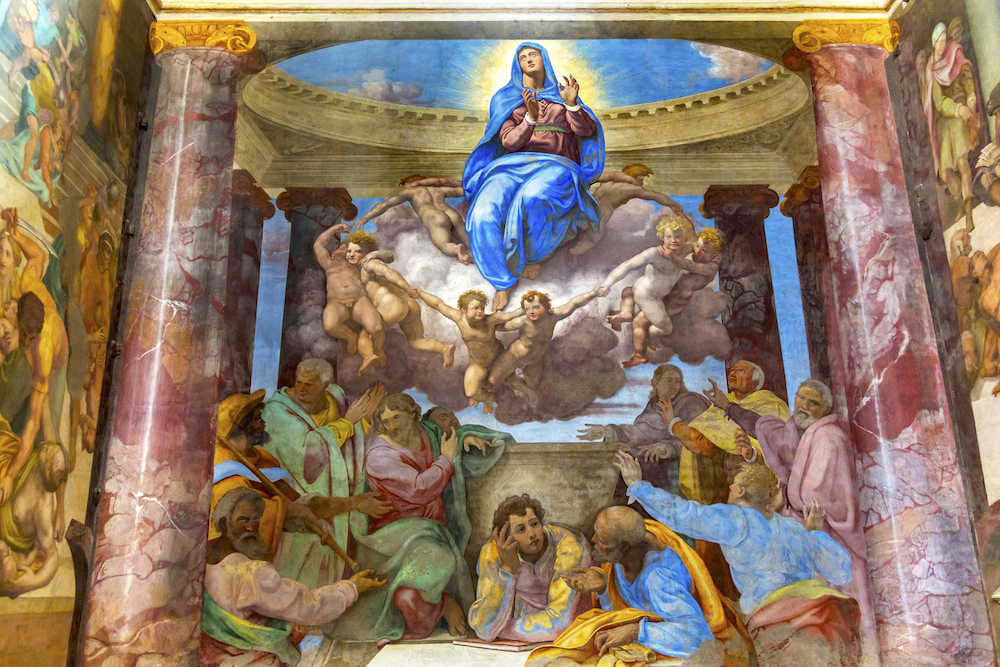Wondering what life after death will be like is as old as it is ongoing. When the Sanhedrin questioned Jesus regarding the resurrection, he explained that after the resurrection those who die will no longer eat or drink, marry or be given in marriage, for they shall live like angels. This subject is one Brant Pitre points out in his book, “Jesus and the Jewish Roots of Mary: Unveiling the Mother of the Messiah”:
“After the resurrection, death will be no more, so there will no longer be a need for offspring. Earthly marriage, bound up as it is with death through procreation, is a temporary part of ‘this age’ or ‘this world’; it will have no place in the ‘that age,’ the age of the bodily resurrection.”
As Christians, we believe that human marriage is a sign of the heavenly marriage that awaits us when we will be united with Christ the Bridegroom of our soul. This is one reason why we celebrate the Assumption of Mary into heaven, which was proclaimed a dogma by Pope Pius XII on Nov. 1,1950.
Mary’s assumption is significant because it prefigures the final resurrection when souls of the just will be reunited with their bodies. Like Mary, they will enjoy the fullness of the beatific vision of God.
Only the spotless Virgin was deemed worthy to be assumed into heaven body and soul; yet her assumption into heaven remains a sign of what is to come for all who are found worthy.
Christian tradition affirms that she was lifted up by God and admitted to the supernatural realm of heaven. Surely, the soul of Mary, who is the fairest flower of our race, was like perfumed incense rising to the throne of God.
Although we stand in awe of our Blessed Mother, we remain hopeful that one day, we too will know the realization of the fullness of our being and be united with the heavenly Bridegroom for all eternity. As pilgrims on the journey, we look to Mary, chosen for our sakes for Christ’s first coming, to clear the path and lighten our way when we meet Christ when he comes again.
We give thanks to God, who gave himself to us through Mary, who is the most perfect of all human beings. Throughout the ages, works of art have proclaimed her glory. Clothed in the blue mantle of baptismal waters in which she was immersed from the moment of her conception, Mary’s purity pervades and penetrates all things.
Nothing in this bride is corruptible. In her person is revealed the infinite majesty of God, for when God created his mother, she became the manifestation of the fullness of his grace.
The reflection of eternal light, Mary is the spotless mirror of God working in and through her to further our understanding of God’s own glory. In return, Mary was so consumed with love for God, that it would seem that her death was a death of love as St. John of the Cross describes in his poem, “A Gloss (with spiritual meaning”:
I went out seeking love and with unfaltering hope,
I flew so high, so high, that I overtook the prey. (P 11.6)
Not only was Mary assumed into heaven, where she reigns as mother of all peoples, her queenship extends to every nation, though her title as queen honors her Jewish roots. It’s not readily apparent to most Christians today why Mary is called “Queen,” since she is not the spouse of Christ the King.
However, when we consider that in biblical times the woman sitting on the throne in the kingdom was not the king’s wife, but the king’s mother, this makes perfect sense. In the Hebrew Scripture kings had large harems.
In the First Book of Kings, we read that King Solomon had 700 wives and 300 concubines (1 Kgs 11:3). Therefore, it would have been impossible to bestow the queenship on a thousand women. Yet, while the king had multiple wives, he had only one mother, which explains why queenship was given to Mary.
Mary is the “eschatological icon of the Church” (CCC 972), meaning the Church contemplates in Mary her own end of times. When we look to Mary, we can surrender ourselves to God in complete trust, knowing that the God who is Love will raise us up as he did his mother.
In that way, the Assumption of Mary into heaven prefigures the ascent into heaven of all the faithful. And so, we ask Mary to intercede for us: Mary, Queen of Heaven, pray for us.

